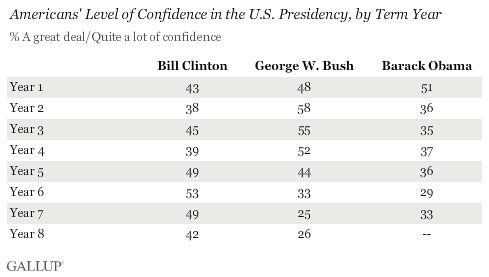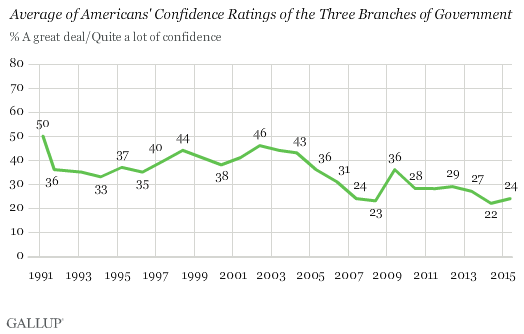Story Highlights
- Americans' confidence in presidency up four points, at 33%
- Thirty-two percent have confidence in the Supreme Court
- Congress retains the least confidence, at 8%
WASHINGTON, D.C. -- Americans' confidence in each of the three branches of the U.S. government remains low, with confidence in Congress and the Supreme Court near their all-time lows reached last year. Currently, 33% of Americans have "a great deal" or "quite a lot" of confidence in the presidency, 32% are this confident in the Supreme Court, and Congress is still well behind, at 8%.

While Congress has consistently received the lowest confidence rating of the three branches of government, the Supreme Court and the presidency usually track each other closely. This is apart from times when the incumbent president has been extremely popular, as in 1991 and 2002, or exceptionally unpopular, as in 2007 and 2008.
Gallup's June 2-7 poll found confidence in the presidency rising slightly to 33% from 29% last year, which in turn was just four percentage points above the historical low of 25% in 2007. The uptick in confidence in the presidency this year is consistent with Americans' higher job approval ratings of President Barack Obama since last fall.
Meanwhile, ratings of the Supreme Court and Congress, which had dropped to record lows in 2014, have barely moved.
Confidence in the Presidency in Obama's Seventh Year Exceeds Bush's
The president in office is not mentioned by name in the confidence in the presidency question, but Americans' evaluations of the sitting president at the time are strongly related to how much confidence Americans place in the presidency as an institution.
Confidence in the presidency as an institution during each year of Obama's presidency has generally been lower than the comparable year in the presidencies of Bill Clinton and George W. Bush. An exception is Obama's first year, when Americans had greater confidence in the institution than in the first years of either Bush or Clinton. Also, in Obama's current year in office, his seventh, confidence in the presidency is higher than the 25% found in Bush's seventh year -- the record low -- but lower than the 49% in Clinton's seventh year.

The highest confidence rating the presidency has ever received is 72%, in March 1991 during the administration of George H.W. Bush shortly after he had succeeded in pushing Iraq out of Kuwait in the Gulf War. However, by October of that same year, after the Gulf War was over, confidence in the presidency had dropped to 50%.
Average Confidence in the Three Branches Is Low, but Has Been Lower
The average confidence rating for the three branches of government combined is 24%, lower than most previous averages since 1991 and well below the high of 50% that year.
But the average of confidence ratings for the three branches of government has been lower -- including in 2008 (23%) and 2014 (22%).

Bottom Line
Americans' confidence in two of the three institutions that make up the U.S. government -- Congress and the Supreme Court -- remains near their all-time lows reached in 2014, while confidence in the presidency, although low, is up marginally compared with last year.
For Congress, low confidence in the institution is nothing new to members of the Senate and the House of Representatives, who have also seen low job approval ratings in recent years. Individual members likely aren't as interested in Americans' collective opinions as they are in the views of the voters they must appeal to back home. But the public's extremely low confidence no doubt weighs on Congress at some level.
The Supreme Court, meanwhile, is not directly accountable to the public -- and often defies public opinion completely. Although its unelected members serve indefinite terms, confidence in the court is not unsusceptible to a drop in confidence in government as a whole.
Survey Methods
Results for this Gallup poll are based on telephone interviews conducted June 2-7, 2015, with a random sample of 1,527 adults, aged 18 and older, living in all 50 U.S. states and the District of Columbia. For results based on the total sample of national adults, the margin of sampling error is ±3 percentage points at the 95% confidence level. All reported margins of sampling error include computed design effects for weighting.
Each sample of national adults includes a minimum quota of 50% cellphone respondents and 50% landline respondents, with additional minimum quotas by time zone within region. Landline and cellular telephone numbers are selected using random-digit-dial methods.
Learn more about how Gallup Poll Social Series works.

